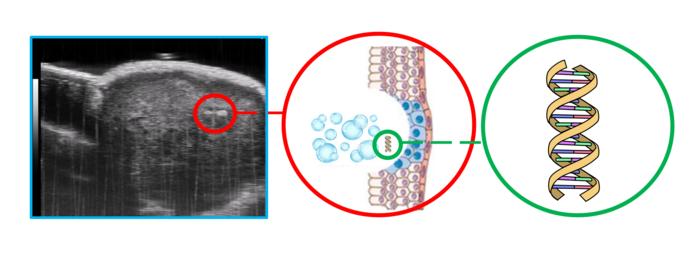OTTAWA, Ontario, May 13, 2024 – Ultrasound imaging offers a valuable and noninvasive way to find and monitor cancerous tumors. However, much of the most crucial information about a cancer, such as specific cell types and mutations, cannot be learned from imaging and requires invasive and damaging biopsies. One research group developed a way to employ ultrasound to extract this genetic information in a gentler way.

Credit: Joy Wang and Pradyumna Kedarisetti.
OTTAWA, Ontario, May 13, 2024 – Ultrasound imaging offers a valuable and noninvasive way to find and monitor cancerous tumors. However, much of the most crucial information about a cancer, such as specific cell types and mutations, cannot be learned from imaging and requires invasive and damaging biopsies. One research group developed a way to employ ultrasound to extract this genetic information in a gentler way.
At the University of Alberta, a team led by Roger Zemp explored how intense ultrasound can release biological indicators of disease, or biomarkers, from cells. These biomarkers, like miRNA, mRNA, DNA, or other genetic mutations, can help identify different types of cancer and inform the subsequent therapy. Zemp will present this work Monday, May 13, at 8:30 a.m. EDT as part of a joint meeting of the Acoustical Society of America and the Canadian Acoustical Association, running May 13-17 at the Shaw Centre located in downtown Ottawa, Ontario, Canada.
“Ultrasound, at exposure levels higher than is used for imaging, can create tiny pores in cell membranes, which safely reseal,” Zemp said. “This process is known as sonoporation. The pores formed due to sonoporation were previously used to get drugs into cells and tissues. In our case, we care about releasing the contents of cells for diagnostics.”
The ultrasound releases biomarkers from the cells into the bloodstream, increasing their concentration to a level high enough for detection. Using this method, oncologists can detect cancer and monitor its progression or treatment without the need for painful biopsies. Instead, they can use blood samples, which are easier to procure and less expensive.
“Ultrasound can enhance the levels of these genetic and vesicle biomarkers in blood samples by over 100 times,” said Zemp. “We were able to detect panels of tumor-specific mutations, and now epigenetic mutations that were not otherwise detectable in blood samples.”
Not only was this approach successful at detecting biomarkers, but it also boasts a lower price compared to conventional testing.
“We’ve also found that we can conduct ultrasound-aided blood testing to look for circulating tumor cells in blood samples with single-cell sensitivity for the price of a COVID test,” said Zemp. “This is significantly cheaper than the current methods, which cost about $10,000 per test.”
The team also demonstrated the potential for applying intense ultrasound to liquefy small volumes of tissue for biomarker detection. The liquified tissue can be retrieved from blood samples or through fine-needle syringes, a much more comfortable option compared to the damaging core-needle alternative.
More accessible techniques to identify cancer will not only allow for earlier detection and treatment but will also allow medical practitioners to be nimble in their approach. They can establish if certain therapies are working without the risks and expenses often associated with repeated biopsies.
“We hope that our ultrasound technologies will benefit patients by providing clinicians a new kind of molecular readout of cells and tissues with minimal discomfort,” said Zemp.
###
———————– MORE MEETING INFORMATION ———————–
Main meeting website:
Technical program:
ASA PRESS ROOM
In the coming weeks, ASA’s Press Room will be updated with newsworthy stories and the press conference schedule at https://acoustics.org/asa-press-room/.
LAY LANGUAGE PAPERS
ASA will also share dozens of lay language papers about topics covered at the conference. Lay language papers are summaries (300-500 words) of presentations written by scientists for a general audience. They will be accompanied by photos, audio, and video. Learn more at https://acoustics.org/lay-language-papers/.
PRESS REGISTRATION
ASA will grant free registration to credentialed and professional freelance journalists. If you are a reporter and would like to attend the hybrid / in-person meeting or virtual press conferences, contact AIP Media Services at media@aip.org. For urgent requests, AIP staff can also help with setting up interviews and obtaining images, sound clips, or background information.
ABOUT THE ACOUSTICAL SOCIETY OF AMERICA
The Acoustical Society of America is the premier international scientific society in acoustics devoted to the science and technology of sound. Its 7,000 members worldwide represent a broad spectrum of the study of acoustics. ASA publications include The Journal of the Acoustical Society of America (the world’s leading journal on acoustics), JASA Express Letters, Proceedings of Meetings on Acoustics, Acoustics Today magazine, books, and standards on acoustics. The society also holds two major scientific meetings each year. See https://acousticalsociety.org/.
ABOUT THE CANADIAN ACOUSTICAL ASSOCIATION/ASSOCIATION CANADIENNE D’ACOUSTIQUE
• fosters communication among people working in all areas of acoustics in Canada
• promotes the growth and practical application of knowledge in acoustics
• encourages education, research, protection of the environment, and employment in acoustics
• is an umbrella organization through which general issues in education, employment and research can be addressed at a national and multidisciplinary level
The CAA is a member society of the International Institute of Noise Control Engineering (I-INCE) and the International Commission for Acoustics (ICA) and is an affiliate society of the International Institute of Acoustics and Vibration (IIAV). Visit https://caa-aca.ca/.
###



